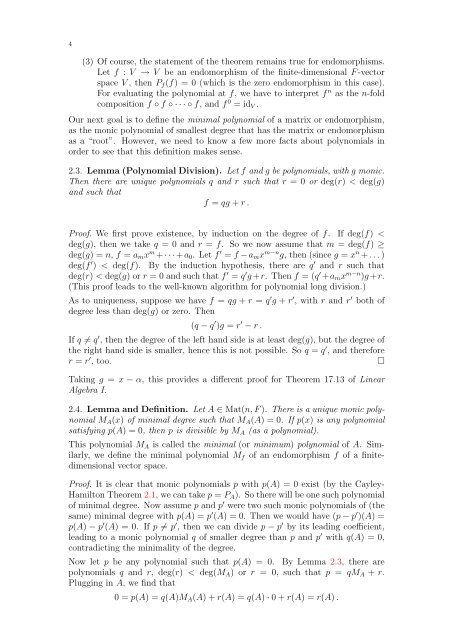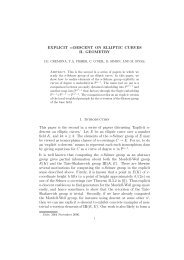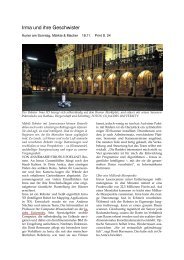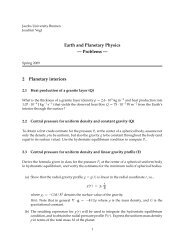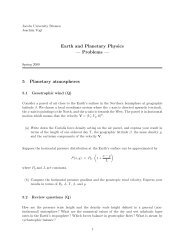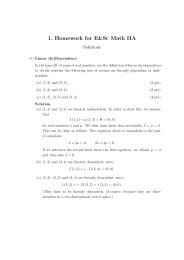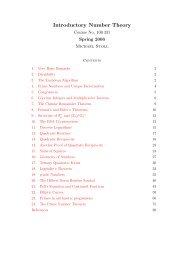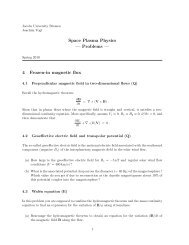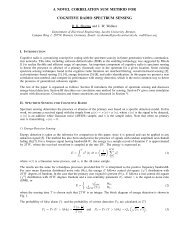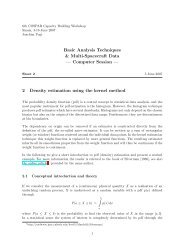Linear Algebra II (pdf, 500 kB)
Linear Algebra II (pdf, 500 kB)
Linear Algebra II (pdf, 500 kB)
Create successful ePaper yourself
Turn your PDF publications into a flip-book with our unique Google optimized e-Paper software.
4<br />
(3) Of course, the statement of the theorem remains true for endomorphisms.<br />
Let f : V → V be an endomorphism of the finite-dimensional F -vector<br />
space V , then Pf(f) = 0 (which is the zero endomorphism in this case).<br />
For evaluating the polynomial at f, we have to interpret f n as the n-fold<br />
composition f ◦ f ◦ · · · ◦ f, and f 0 = idV .<br />
Our next goal is to define the minimal polynomial of a matrix or endomorphism,<br />
as the monic polynomial of smallest degree that has the matrix or endomorphism<br />
as a “root”. However, we need to know a few more facts about polynomials in<br />
order to see that this definition makes sense.<br />
2.3. Lemma (Polynomial Division). Let f and g be polynomials, with g monic.<br />
Then there are unique polynomials q and r such that r = 0 or deg(r) < deg(g)<br />
and such that<br />
f = qg + r .<br />
Proof. We first prove existence, by induction on the degree of f. If deg(f) <<br />
deg(g), then we take q = 0 and r = f. So we now assume that m = deg(f) ≥<br />
deg(g) = n, f = amx m + · · · + a0. Let f ′ = f − amx m−n g, then (since g = x n + . . . )<br />
deg(f ′ ) < deg(f). By the induction hypothesis, there are q ′ and r such that<br />
deg(r) < deg(g) or r = 0 and such that f ′ = q ′ g +r. Then f = (q ′ +amx m−n )g +r.<br />
(This proof leads to the well-known algorithm for polynomial long division.)<br />
As to uniqueness, suppose we have f = qg + r = q ′ g + r ′ , with r and r ′ both of<br />
degree less than deg(g) or zero. Then<br />
(q − q ′ )g = r ′ − r .<br />
If q = q ′ , then the degree of the left hand side is at least deg(g), but the degree of<br />
the right hand side is smaller, hence this is not possible. So q = q ′ , and therefore<br />
r = r ′ , too. <br />
Taking g = x − α, this provides a different proof for Theorem 17.13 of <strong>Linear</strong><br />
<strong>Algebra</strong> I.<br />
2.4. Lemma and Definition. Let A ∈ Mat(n, F ). There is a unique monic polynomial<br />
MA(x) of minimal degree such that MA(A) = 0. If p(x) is any polynomial<br />
satisfying p(A) = 0, then p is divisible by MA (as a polynomial).<br />
This polynomial MA is called the minimal (or minimum) polynomial of A. Similarly,<br />
we define the minimal polynomial Mf of an endomorphism f of a finitedimensional<br />
vector space.<br />
Proof. It is clear that monic polynomials p with p(A) = 0 exist (by the Cayley-<br />
Hamilton Theorem 2.1, we can take p = PA). So there will be one such polynomial<br />
of minimal degree. Now assume p and p ′ were two such monic polynomials of (the<br />
same) minimal degree with p(A) = p ′ (A) = 0. Then we would have (p − p ′ )(A) =<br />
p(A) − p ′ (A) = 0. If p = p ′ , then we can divide p − p ′ by its leading coefficient,<br />
leading to a monic polynomial q of smaller degree than p and p ′ with q(A) = 0,<br />
contradicting the minimality of the degree.<br />
Now let p be any polynomial such that p(A) = 0. By Lemma 2.3, there are<br />
polynomials q and r, deg(r) < deg(MA) or r = 0, such that p = qMA + r.<br />
Plugging in A, we find that<br />
0 = p(A) = q(A)MA(A) + r(A) = q(A) · 0 + r(A) = r(A) .


